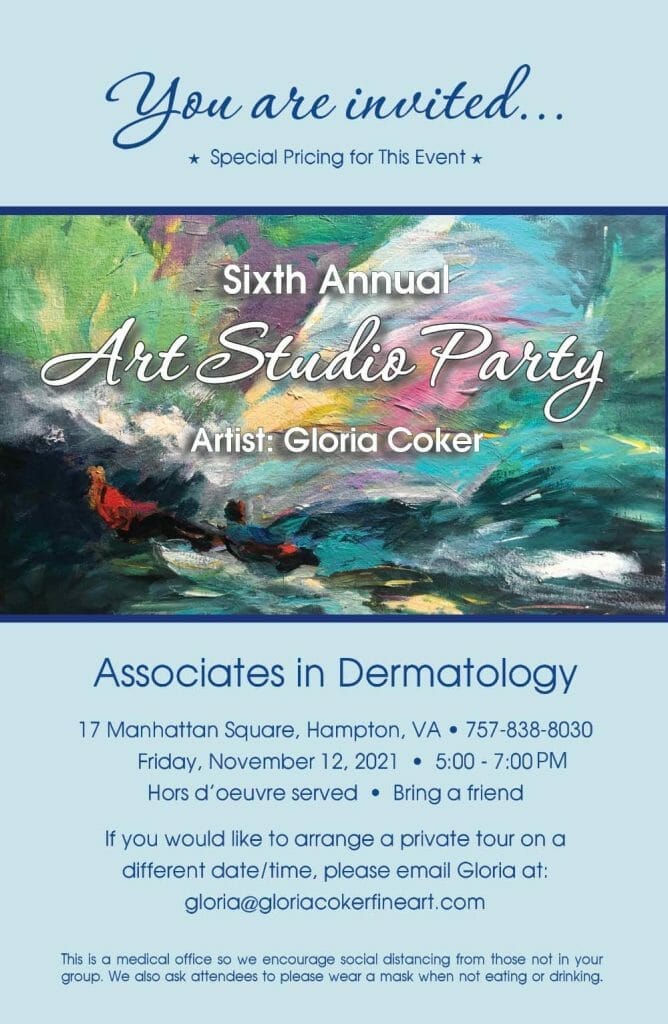The other day I spent 5 hours hanging my art at the Associates in Dermatology office for my upcoming Art Show and Sale on Nov 12. Those working artists who exhibit will understand the process involved in managing an art business. There is much to do after the paint dries.
Displaying a large show, removing and storing wall art, replacing with new art, labeling, and pricing is tedious. But now I should be able to relax. Though the party elements still need to be addressed and I have lots of help there.
I enjoy talking about my art and my process, but having been doing art for so long I hope you, dear reader (don’t you love that phrase?), might find it interesting to understand what happens after the paint dries.
There is no magical leap from the easel to the spot on the exhibition wall. Those who paint purely for pleasure with no need to display, much less sell their work, need not concern themselves with the messy business of art. In truth the hours spent can sometimes be longer than the hours spent painting.
Let’s start by listing what artists need to acquire in order to do their work.
- Obviously, a place to paint. I find the best place is a studio with a door. It could be a room in your house. I have known artists who had to clean off their dining room table for dinner. I can’t imagine how anyone can paint seriously without a place of their own.
- Then purchasing painting supplies (which are expensive). One would like to be able to pay for them by selling one’s art.
- Next, I’ve found it helpful and necessary to build a database to keep track of where your art is located, who bought what and on and on. It’s easy to forget what gallery is showing what painting, what collection purchased which pieces (in case they return for more!), and what family member has your favorites.
- Most folks who are not en plein air or non-objective painters need some reference material. Think photography and a good iPhone (currently replacing the sturdy Nikons and Canons). My iPhone 8 has become woefully inadequate so an iPhone 13 is in my headlights.
- Then we need printers that work well and of course, include those pricey inks.
- You need your tools which include pigments, brushes, canvas, easel, and more. I, fortunately. have a large home studio with lots of storage so I can stockpile.
I have worked with many themes, series, subject matter and it always seemed that I had another idea to work on. Lately, it has become more difficult to get excited, but I am working on it. There are several new projects that I am interested in tackling.
- Back to actually painting…I paint and stop. Then after a long time of consideration, I feel it is done.
- And then I need a frame unless, of course, the canvas is gallery wrapped and needs no frame. Add the hangers and wire and the framing part is done.
- Next is photographing the finished painting. I fortunately took enough photography classes that the next step was to declare it a major to which I said that I had enough degrees! When I worked as a newspaper illustrator I learned from my photographer colleagues that the best lighting was bright shade. I followed my friend Ransy Morr outside the building and watched her shoot various items in the bright shade of the building. Works for me.
- Finally, the photo needs to find a home on my computer where I catalog all of my work by category. Each painting is documented in my database that I referenced earlier.
You can see professional artists have a time-consuming business. It’s not all fun and painting.
If applying to a show, each piece of art has to follow the submission guidelines including such things as resolution, title, and size. However, this is my personal show. I hang what I please, but still make sure to include the title (you can see the size on the wall) and of course a price.
So to see the results of all these steps, stop by my Art Show and Sale on November 12, 2021.


